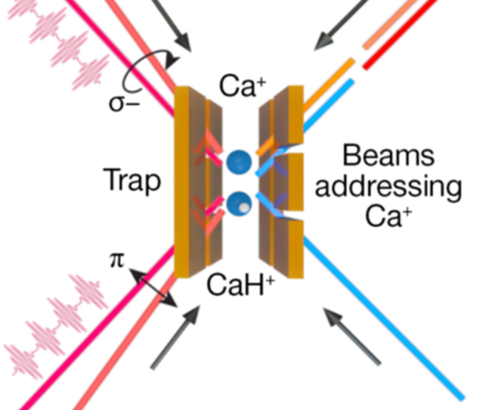Summary
Our research focuses on the use of quantum logic techniques to prepare, control, and measure the rovibrational and electronic states of single trapped molecular ions using co-trapped atomic ions.
Description
Spectroscopy and Quantum Control of Molecular Ions

Molecules exhibit vibration and rotation of their nuclei, degrees of freedom not present in atoms, and less stringent selection rules for transitions. This creates experimental challenges and great opportunities for exploring new physics. In this project, the tools of quantum information processing developed on atomic ions are extended to performing precision measurement and quantum-state control of single molecular ions.
In the experiments, a molecular ion is trapped alongside an atomic ion in a linear radio-frequency (rf) Paul trap. The translational motions of the two ions are coupled via the Coulomb interaction and well described by normal modes of harmonic motion. By laser cooling the atomic ions, the shared motional modes can be cooled to the quantum mechanical ground state. By driving a motional “sideband” of a molecular transition, a motional mode can be excited from the ground state along with a change in the molecular state. The information about the quantum states of the molecule can thus be transferred to that motional mode and further to the atomic ion by another sideband transition, The state information on the atomic ion can be read out by observing state dependent fluorescence, where the atomic ion either emits many photons of which some can be detected or remains dark, corresponding to whether the transition in the molecule was successfully driven or not. This transduction of quantum information from the molecular ion to the atomic ion has enabled preparation and nondestructive detection of a CaH+ ion in pure quantum states [chou17], and entanglement between a molecular ion and an atomic ion [lin20].
Only two lasers are required to facilitate coherent manipulation of molecular states connected by transitions spanning from radio- to optical frequencies in the experiment. A continuous-wave (CW) laser is used to drive stimulated Raman transitions (SRT) with frequencies below 100 MHz and a pulsed optical frequency comb (OFC) is employed to drive SRT with frequencies from 100 MHz to > 1 THz. The pulses from two beams derived from the OFC collide at the molecular ion to create beat notes equally spaced by the pulse repetition rate in frequency space and thus can be used to drive a wide range of transitions covered by the spectral extent of the OFC. The OFC has enabled high precision rotational spectroscopy in CaH+ [chou20] and recently achieved sub-part-per-trillion spectral resolution [collopy23].
The lasers addressing the molecule are far detuned from any molecular transitions and the same lasers can be used to drive transitions in many molecular species. Therefore, the experimental apparatus is expected to be applicable to a broad range of molecular ion species. Currently the background blackbody radiation is believed to be limiting the observed lifetimes of the molecular states. A new apparatus designed for cryogenic operation near 4 Kelvin is currently under construction. At these temperatures the vacuum should be much improved and blackbody radiation intensity is significantly suppressed. The new setup should enable us to explore molecular species with increased complexity, including polyatomics.
Quantum-state resolving preparation, detection and control of molecular ions are expected to offer new opportunities in quantum information processing (QIP), precision spectroscopy, and fundamental physics. The variety of molecular properties offered by a large number of species can unlock functionality, such as transitions that emit photons in the telecom wavelength band, for trapped ion QIP platform. Precision spectroscopy of molecular species with enhanced sensitivities for tests of fundamental physics, including time-variations of the electron-to-proton mass ratio and the electron electric dipole moment, could provide windows into physics beyond the Standard Model. In chemistry, molecular-state specific control could contribute to quantum control of chemical reactions.
[collopy2023] A. L. Collopy, J. Schmidt, D. Leibfried, D. R. Leibrandt, and C. W. Chou, Effects of an oscillating electric field on and dipole moment measurement of a single molecular ion, Phys. Rev. Lett. 130, 223201 (2023).
[lin2020] Y. Lin, D. R. Leibrandt, D. Leibfried, and C. W. Chou, Quantum entanglement between an atom and a molecule, Nature 581, 273 (2020).
[chou2020] C. W. Chou, A. L. Collopy, C. Kurz, Y. Lin, M. E. Harding, P. N. Plessow, T. Fortier, S. Diddams, D. Leibfried, and D. R. Leibrandt, Frequency-comb spectroscopy on pure quantum states of a single molecular ion, Science 367, 1458 (2020).
[chou2017] C.-W. Chou, C. Kurz, D. B. Hume, P. N. Plessow, D. R. Leibrandt, and D. Leibfried, Preparation and coherent manipulation of pure quantum states of a single molecular ion, Nature 545, 203 (2017).
Personnel
Staff: James Chin-Wen Chou, Dietrich Leibfried
Postdocs: Baruch Margulis
Graduate students: Dalton Chaffee, Cheryl Liu, April Sheffield
Selected recent publications
Y. Liu, J. Schmidt, Z. Liu, D. R. Leibrandt, D. Leibfried, and C. W. Chou, Quantum state tracking and control of a single molecular ion in a thermal environment, Science 385, 790 (2024).
A. L. Collopy, J. Schmidt, D. Leibfried, D. R. Leibrandt, and C. W. Chou, Effects of an oscillating electric field on and dipole moment measurement of a single molecular ion, Phys. Rev. Lett. 130, 223201 (2023).
Y. Lin, D. R. Leibrandt, D. Leibfried, and C. W. Chou, Quantum entanglement between an atom and a molecule, Nature 581, 273 (2020). PDF
C. W. Chou, A. L. Collopy, C. Kurz, Y. Lin, M. E. Harding, P. N. Plessow, T. Fortier, S. Diddams, D. Leibfried, and D. R. Leibrandt, Frequency-comb spectroscopy on pure quantum states of a single molecular ion, Science 367, 1458 (2020). PDF
C.-W. Chou, C. Kurz, D. B. Hume, P. N. Plessow, D. R. Leibrandt, and D. Leibfried, Preparation and coherent manipulation of pure quantum states of a single molecular ion, Nature 545, 203 (2017). PDF

